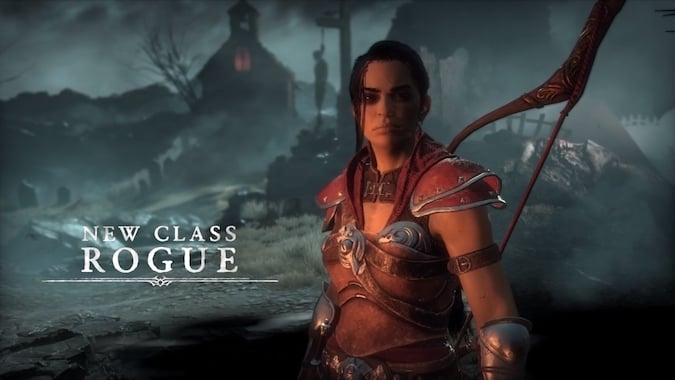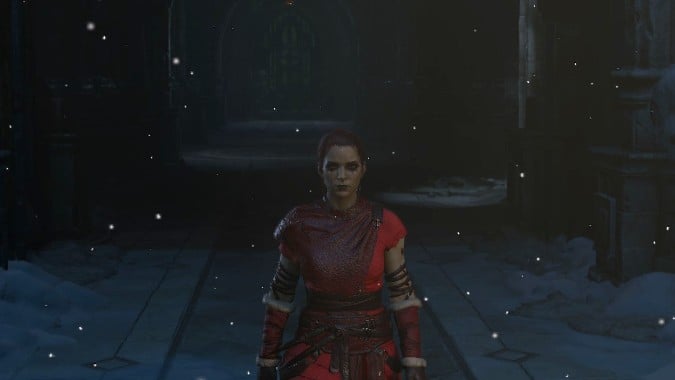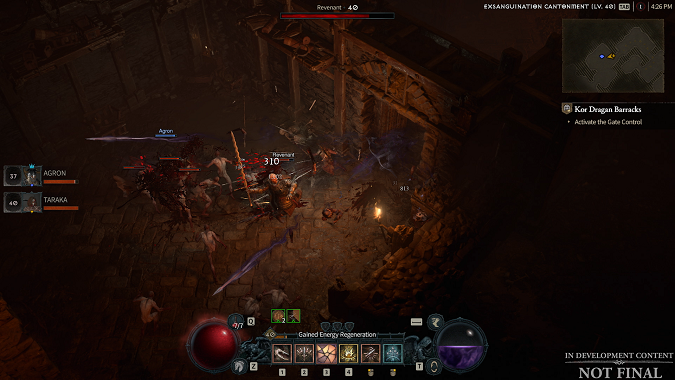How to get started with the Rogue in Diablo 4

Diablo 4 Season 1 is nearly here and if you’ve decided to explore Sanctuary this time as a blade concealed in shadows or an archer defeating enemies from afar, you’ll want to play the Rogue. A dexterous class which weaves between enemies to deal harsh blows, the Rogue uses imbuements of Shadow, Frost, or Poison to control and hurt enemies, favoring precision over bursting to defeat the demons. Getting started with a Rogue isn’t all that different from other classes and if this isn’t your first character you’ll be able to pick up the basics pretty quickly.
But if you’re not sure where to start, we have the tips you need to start leveling a Rogue in Diablo 4. If this is your first character and/or you’re not all that confident in your game skills yet you’ll want to start at World Tier 1 difficulty. You’ll level a little slower, but you’ll also spend less time being dead. Once you feel comfortable with the class you should give World Tier 2 a chance, because it provides more experience — although be prepared to drop back down to 1 if you’re struggling. To stay alive, be sure to use your healing potion when needed and upgrade it when available; since you start off with a potion cap of four and healing potions are a common drop there’s no reason to hoard or save them for emergencies. In addition all classes start off with Evade to help dive out of an attack, use it as often as you can as standing still for too long is a surefire way to end up dead. For more survival tips as Rogue check out our guide here.
Rogues have three weapon slots to use: a ranged slot for a bow or crossbow and two melee slots for daggers or swords (other weapons are not usable by the Rogue class). Ranged vs melee is the main decision that a Rogue player will make when leveling their character, and it’s a good idea to choose early on which playstyle you prefer as it’ll make it easier to choose abilities that augment that playstyle. Note that ranged weapons can still be used when in melee combat so if all you want to do is fire arrows you can do so without worrying about where the enemy is located. Regardless of which you choose, however, you’ll want to keep upgrading all weapons when you can as all stats except weapon damage will apply regardless of whether an ability uses the weapon. Armor is generic in Diablo 4 so the same piece can be worn by any class, but when leveling you’ll want to focus on Dexterity as your primary stat.
The main resource for the Rogue is Energy, and it’s passively regenerated (although that regeneration can be increased through skills and equipment). As such you can start combat with Energy-spending abilities without worrying about building the resource up — however, if you spend all your Energy during combat you’ll need to rely on Basic Skills until the gauge has refilled. In practice you’ll want to weave Basic Skills and skills requiring Energy in order to ensure you’ll have enough Energy for when you need it.
If you’ve previously earned bonus Skill Points via Renown and/or are starting the Rogue after completing the Campaign you’ll have more options available to you — including a Mount and the option not to follow the Campaign. As such this guide will only discuss the usage of Skill Points and class features regardless of how you’ve earned them.
So let’s talk about how to get started with the Rogue class in Diablo 4.

Skill Points and Basic Abilities for the Rogue
When you acquire your first Skill Point — either earned by a previous character from Renown or by reaching Level 2 — you’ll be able acquire your first Basic Skill. There are five to choose from, and each is designed with a different playstyle in mind.
- Invigorating Strike is a melee ability that increases your Energy regeneration for a short period of time after use.
- Blade Shift is a melee ability that lets you freely move between (and away from) enemies when used.
- Puncture is a short range ability that uses your melee weapons to keep enemies off of you.
- Heartseeker is a ranged ability where the arrow seeks its victim — you’re trading off the ability to target a specific mob with a higher guarantee you’ll hit any mob (although you can still miss entirely if you’re firing in the wrong direction).
- Forceful Arrow is a ranged ability where you’ll need to aim at your enemy to hit them, and every third arrow makes the target Vulnerable to extra damage.
As a new Rogue player you’ll want to choose a Basic Skill that addresses your intended playstyle. While Skill Points can be refunded, it is only free to do so for the first 8 levels after which there is an increasing cost to rework your points. In addition, while it’s tempting to consider choosing two Basic Skills the game is designed around your eventual six abilities coming from each of the six skill tiers in the Ability tree, so only choose one of these to use.
Each Basic Skill has five ranks of damage, but your subsequent Skill Points are better spent on the Enhanced option before putting more points into the skill itself. Rogue skills except for Ultimate abilities have an Enhanced node that does as it describes, enhancing the Basic Skill when used — and they tend to provide bigger boosts than simply leveling up the skill. As these effects are largely passive they don’t require playstyle modification to take advantage of, although you should review the individual descriptions to see the benefit it gains.
Beyond the Enhanced mode is a choice between a Fundamental node and a Primary node — you can only choose one of them. Most of the choices are between increased damage and increased number of targets, so when you have the opportunity to spend a Skill Point here you should do so. However, after you’ve selected the Enhanced mode you’ll have unlocked the Core Skill tier and you’ll want to spend points there before augmenting your Basic Skill any further.

Core and Agility skills for the Rogue
Core Skills are unlocked with your third Skill Point, either earned from Renown or by reaching Level 4. Core Skills are the Energy spenders that you’ll use to deal the most damage until you unlock your Ultimate ability, so you’ll want to maximize your usage of them. Like Basic Skills, your Core Skills have five ranks of damage with an Enhanced node and a choice of Improved or Advanced. The Core Skill tree also has some non-ability bonuses you can choose, however, as you’re just starting off you’ll want to save these for much later so don’t worry about them for now.
Your Core Skill choices are:
- Flurry is a melee ability that deals strong damage to enemies that are in front of you.
- Twisting Blades impales your enemy with your blades, and then return to you dealing damage to anyone caught in the path.
- Barrage unleashes a spread of arrows that can ricochet off enemies.
- Rapid Fire quickly fires a stream of arrows in one direction.
- Penetrating Shot pierces through enemies in a line.
Each of the abilities have their positives and negatives. Obviously Flurry and Twisting Blades are for those who want to melee, with Twisting Blades pairing well with the Basic Skill Blade Shift. Barrage will help damage more enemies, while Rapid Fire is better at downing one enemy at a time. Penetrating Shot rewards those who are patient with positioning, allowing them to deal a devastating blow to multiple opponents at once.
Since you’re still able to refund points for free, this is the time to experiment the most with Basic and Core Skills to see which ones you enjoy using the most. Try them all out and see which ones work for you. You can even hybrid a melee Skill with a ranged Skill for maximum versatility, but you’ll want to make sure you have sufficient means of getting from ranged to melee to ensure you’re not spending a lot of time running in or out of groups. Fortunately the next tier of Skills — Agility — will help with that.
Before you unlock Agility Skills, however, you need to acquire 7 Skill Points. At this point you should have chosen a Basic and Core Skill and have selected the Enhanced nodes and one of the choice nodes for each.
Unlike the previous two tiers there are only three ability options in the Agility Tier. These options are all about movement — while dealing damage as well. Usage is dictated by their cooldown and charges, which can be modified by equipment.
- Dash is your gap closer, moving you closer to enemies and striking out at them.
- Caltrops is used to jump backwards and gain separation, leaving caltrops on the ground that damage and slow enemies that follow.
- Shadow Step helps move between targets, allowing you to get behind your victim regardless of what’s in your way.
For those who prefer melee playstyle, Dash will ensure you spend more time in combat while Caltrops is better suited for those who prefer Ranged combat as it helps create some space. Shadow Step is for those who want to dance between opponents — you can do serious damage this way, but you may find yourself overwhelmed without the gap management the other abilities provide.
As in previous tiers your next Skill Point should be put into the Enhanced node of the Agility Skill. The choice nodes are labeled as Methodical or Disciplined, and should be where the next Skill Point is used. After that you’ll have two Skill Points to place before unlocking the next tier, so either increase the rank of a Skill or select one of the passive options (Weapon Mastery is a nice catch-all).

Subterfuge Skills and Specializations for the Rogue
Your 12th Skill Point can be used to unlock one of four Subterfuge Skills. Without the assistance of Renown you’ll unlock this tier at level 13. This tier has the most variety, with four different Skills available that you’ll want to choose from based on which you feel best complements your playstyle. Because Skill Points now cost gold to refund, you may wish to play around with all four abilities now rather than commit to one and change it later when the refund cost is higher. Like Agility Skills, Subterfuge Skills utilize cooldowns that can be modified.
The choices are:
- Poison Trap arms after 1.25 seconds and is triggered by a nearby enemy to fill the area with poisonous gas for 9 seconds.
- Smoke Grenade will Daze enemies that are in the landing zone.
- Concealment allows you to enter Stealth for 5 seconds and lets you move freely through obstacles. Taking damage will not break the Stealth, but using another ability will.
- Dark Shroud surrounds you with protective shadows that reduce the amount of damage you take.
Poison Trap and Smoke Grenade are your crowd control abilities, while Concealment is a great way to position yourself to do damage on unsuspecting enemies. Dark Shroud is the most passive of the bunch, providing a straight damage reduction on a twenty second cooldown — although since it only can take five hits before removal, it won’t help you survive jumping into a huge pack of mobs. As with previous tiers, your next Skill Points should be spent on the Enhanced node of your chosen Subterfuge Skill and the subsequent choice node (titled Subverting and Countering).
Level 15 is when Specializations become available for the Rogue via a quest chain that unlocks Combo Points, which increase the damage of Core Skills by using Basic Skills. For more information on Specializations check out our guide.

Getting Advanced with the Rogue: Imbuements, Ultimates, and Legendaries
At this point in your Rogue journey you should feel a lot more comfortable with your playstyle selection and the benefits provided by the class. As you continue to gain levels and Skill Points there are two more tiers that you’ll unlock: Imbuements and Ultimates. Imbuements modify your Core Skills with Shadow, Poison, or Cold, dealing more damage and inflicting more negative statuses on your opponents. If you haven’t gained any Skill Points from Renown you’ll unlock Imbuements at level 18.
Ultimate Skills will be unlocked at level 25 if you only gain Skill Points from leveling, and are a tremendous gain in the amount of damage you can do in combat. While the cooldown on these abilities are long — 50 to 60 seconds — setting up your enemies for their usage can result in a tremendous amount of damage and can mean the difference between an easy fight and an early death.
The one last thing Rogues should be aware of is Legendary items. Obviously if this isn’t your first playthrough in the Diablo franchise you’ll already be familiar with them, but it’s important to note that many Rogue Legendaries include Ability Ranks and as such you may find yourself at a low level having unlocked Imbuements or Subterfuge Skills via the Legendary. You won’t be able to augment them (the Skill Point unlock requirement is for the entire tier), but you may get a chance to try out a skill earlier than expected. You also may find yourself with a new Skill in a tier you’ve already chosen a different Skill from — take advantage of the free unlock to try that Skill out, you may find you like it more than one you’ve previously used.
Whether you choose to spend your time in melee, at range, or bouncing back between the two, Rogue is a fun class for those who enjoy a little precision and elegance in their combat. Players will do their best if they choose Skills that reflect their own desired playstyle rather than those copied from a website to maximize damage. Experiment early and often to find the style that best suits you and your journey through Sanctuary will be a successful one.
Originally published May 30. Updated July 18.
Please consider supporting our Patreon!
Join the Discussion
Blizzard Watch is a safe space for all readers. By leaving comments on this site you agree to follow our commenting and community guidelines.
 @Kalcheus
@Kalcheus




